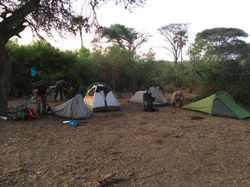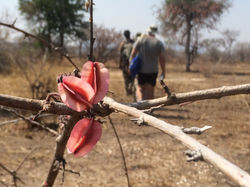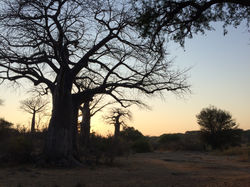
EXPEDITION WILD

Ruaha National Park, Tanzania
10 day, unlimited accesss to one of Tanzania's greatest wilderness areas.
Expedition Basics:
Dates: Late August – Early September
Total length of trip: 12 days, 10 days on foot.
Estimated distance: 10km - 16km/ day
Altitude climb: 560m to 1500m
Getting there: Fly from JHB South Africa to Dar es Salaam, Dar es Salaam to Iringa then transfer by road to Ruaha National park
Getting Back: Same as getting there.
Equipment Needed: You need to carry everything you need for the trip! Tent, food etc.
Overview:
The trip was escorted by two very experience Tanzanian trails guides, Christoline Motta and Lazaro Ngoikai who knew the area well. We were lucky enough to have unlimited access to a large part of the park, thanks to the help and support of the Chief Warden and his enthusiastic staff. In 10 days we managed to covered the three main sectors along the Ruaha River, the Southern Lunda portion, the Central region and the Northern Jongomero area. Our expedition comprised of setting up base camp every other day in a new location of our choice, with the days spent exploring the area around the base camps along the river. Wildlife was prolific with daily signs of lions, elephants and general game. Lions were very vocal and came right into camp on two nights. Truly one of the great wilderness areas left on the continent.
 |  |  |
|---|---|---|
 |  |  |
 |  |  |
 |  |  |
 |
The Great Ruaha:
Ruaha National Park is Tanzania's largest and most vast wilderness situated in the south-west of the country, and is only visited by a handful of travellers each year. At the park's heart is the aptly-named Great Ruaha River, a massive watercourse that dwindles to only a few pools in the dry season, but bursts its banks and roars over boulders at the height of the rains. Converging with the Great Ruaha are hundreds of sand rivers, and natural game corridors when dry and sparklingly clear streams when wet. Waterbuck, impala and the world's most southerly Grant's gazelle risk their lives for a sip of water - the shores of the Ruaha are a permanent hunting ground for lion, leopard, cheetah, jackal, hyena and the rare and endangered African wild dog. Ruaha's elephants are recovering strongly from ivory poaching in the 1980's and remain the largest population in East Africa. Ruaha represents a transition zone where eastern and southern species of flora and fauna overlap - lesser and greater kudu co-exist with northern species such as Grant's gazelle.
 |  |  |
|---|---|---|
 |  |  |
 |  |  |
 |